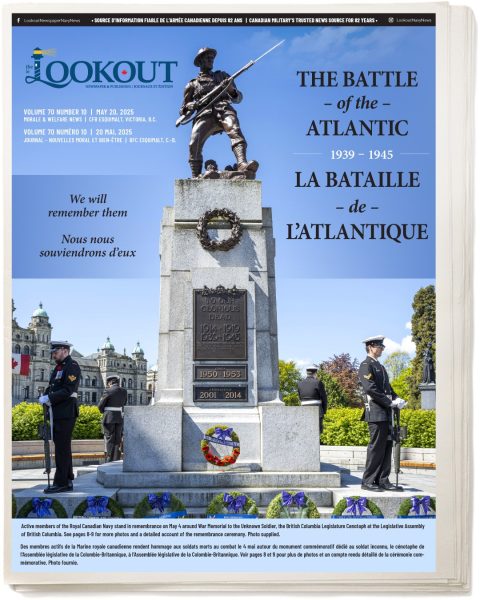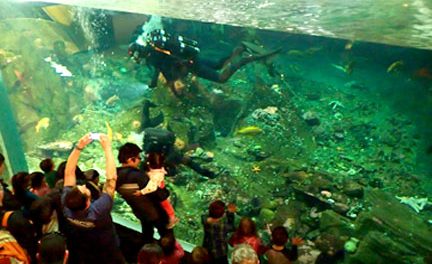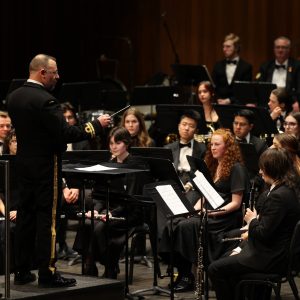
Commissionaire Gary Restell examines a photograph from 1914 depicting a march of Canadian soldiers and sailors through Dockyard at the archives of the CFB Esquimalt Naval and Military Museum. Photos: Peter Mallett/Lookout Newspaper.
Peter Mallett,
Staff Writer
—
The unsolved riddle of a historic photo, a poignant moment in Dockyard history 110 years ago, mesmerized Commissionaire Gary Restell.
The black and white photo was taken on Aug. 23, 1914. It shows a parade of hundreds of young Canadian soldiers and sailors marching up Esquimalt Road, days before some of them departed to the battlefields of Europe.
“The photo represents Victoria’s contribution to the Great War overseas and is just dripping with military history,” explains Restell. “It depicts the first wave of volunteers making final preparations before heading to the front.”
The 78-year-old retired sales and marketing professional has worked at the Naden and Dockyard Gates as a security guard for the past ten years and is fascinated with the rich military history of CFB Esquimalt.
There were no details on the public record to answer the riddle of why, when and where the soldiers were marching when he first spied the photo. This stoked Restell’s curiosity and just like a detective working on an unsolved caper, with magnifying glass in hand, he began to look more closely at the details and identifiers in the photo.
“Little did I know what I had gotten myself into and I gradually became a full-time library and research sleuth because of this curiosity,” he says.
Restell eventually found himself spending endless hours of his spare time studying online archives of local newspapers and other sources, asking questions of local historians at the CFB Esquimalt Naval and Military Museum, Esquimalt’s archives and the Royal BC Museum. In the end, his sleuthing and persistence paid off.
Facts Revealed
Through his investigation, Restell uncovered that the photo was taken on Sunday, Aug. 23, 1914, and involved soldiers of the 88th Victoria Fusiliers, Band of the 5th (British Columbia) Field Regiment, and Royal Canadian Artillery CGA, who were headed to Valcartier, Que., before heading to the front lines in Europe. Members of HMCS Rainbow and members of the newly formed Royal Canadian Naval Volunteer Reserve also attended the parade in support of the deploying troops.
The parade was marching from the naval dockyard to St. Paul’s Naval and Garrison Church located on Esquimalt Road for a ‘Valedictory Service’ – this was the last opportunity for the soldiers to attend regimental prayer. Restell eventually confirmed their attendance in the church’s record of services.
A few days after the farewell celebration at the church, seventy members of the 5th (British Columbia) Field Regiment boarded steamship S.S. Princess Mary at the Canadian Pacific Railway Wharf and head to Valcartier.
Then, on Aug. 28, the combined forces of 500 members from the 88th Victoria Fusilliers and 50th Gordon Highlanders marched through downtown Victoria towards the Warf to board S.S. Princess Sophia headed to Valcartier as well.
But the human side of his research revealed upsetting details, says Restell.
“All of these people were volunteers and the first wave of men to go overseas; sadly, a lot of them wouldn’t be coming back,” he said. “So many of them were caught up in the spirit of the day, but there is nothing romantic or intriguing about war. Many of them died brutal deaths at the hands of the enemy or suffered permanent injury.”
Snapshot Sleuthing
This is not the first time Restell dug into the archives searching for information on an undated photo.
About seven years ago when he was researching Esquimalt’s streetcar system of the late 1800s and early 20th century, he found a photo depicting tracks along Esquimalt Road with a military parade marching out of Dockyard. The undated photo had no description of who was in the photo or what was going on; it simply stated, ‘Naval parade in Esquimalt’.
His research and inquiries then revealed a second photo showing the back end of the parade. Taken from the same position its archive notation incorrectly stated the marchers were ‘leaving dry dock in Esquimalt for a day of manoeuvers’.
On the hunt to find the truth about both photos he was aided by the assistance of local historian Jack Bates of the Organization for the Preservation of Canadian Military History (OCPMH) and CFB Esquimalt Navy and Military Museum archivist Joseph Lenarcik. Restell says the story and facts about the parade gradually began to unravel.
According to his research, the soldiers in the front of the parade were the 5th (BC) Field Regiment because they wore white-covered forage caps, part of the required clothing for the first wave of soldiers from the regiment in the war. He could also tell that because of the flutes played by band leading the parade that it was most likely the Fife and Drum Band of the Victoria Fusiliers.
“It was extraordinary to come to the conclusion that two pictures of what I thought were two different parades with two militias and the navy and naval reservists, and four distinct organizations involved, were actually two photos of the same parade,” said Restell.
Lenarcik said Restell has a keen eye for observing the world around him and searching for specific information.
“I admire him for his willingness to take on a project and test out his hypothesis until he arrives at a final answer that can’t be disproved,” said Lenarcik. “Like Sherlock Holmes, he methodically attacks all the possible answers until only one answer is left.”
Restell says his appetite for such time-consuming research is waning while he eyes the option of full-fledged retirement coming in the months ahead.
“I’ve enjoyed meeting the challenge of pursuit but it’s time to move on to explore other avenues of interest,” he said. “But I will still look forward to hearing from anyone about the picture of the parade and its subject matter.”

An image from Aug. 27, 1914 of The Daily Colonist newspaper depicting a farewell at Victoria’s Canadian Pacific Railroad Steamship terminal for volunteer soldiers bound for the First World War battlefields of Europe.













